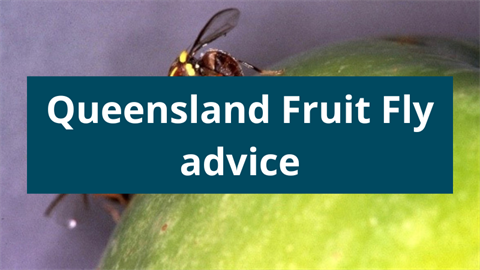Protect your garden from Queensland Fruit Fly
Published on 23 August 2024

PROTECT YOUR GARDEN FROM QUEENSLAND FRUIT FLY
If you have fruit trees or fruiting vegetables in your garden, it’s important to start preparing your garden for Queensland fruit fly.
Queensland fruit fly is a significant horticultural pest that is found in Victoria. It is most active between spring and summer and creates problems for home gardeners and commercial growers because it attacks a wide range of fruits and fruiting vegetables, leaving them inedible.
Adult Queensland fruit fly are about 7mm long and are reddish-brown in colour, with distinct yellow markings. It attacks many fruit and fruiting vegetables including tomatoes, stonefruits, figs, capsicums, citrus, cherries and berries, so home gardeners need to monitor and use control methods to protect fruits if they want a harvest.
Home gardeners can use traps to monitor Queensland fruit fly activity in gardens. Different traps are available from nurseries, home garden and online retailers that use attractants to lure Queensland fruit fly inside the trap, where they are killed by an insecticide or trapped by a liquid or sticky surface. Traps can also be made at home using an empty soft-drink bottle and homemade bait.
Host fruits and vegetables should also be monitored for signs of attack. Check fruit skins for sting marks and cut them open to check inside for maggots.
There are a wide range of products available from nurseries and hardware stores to help home gardeners control Queensland fruit fly and protect fruit from damage. The most effective way to stop Queensland fruit flies from damaging fruit and vegetables is to cover host plants and trees with insect proof netting, securing it around the base of the tree trunk or to the ground. Bags or sleeves can also be used to protect fruits. These exclusion barriers will stop Queensland fruit flies from reaching and laying eggs inside fruit and is helpful if nearby trees are infested with Queensland fruit flies and not managed. There also baits, insecticides and traps available to control Queensland fruit fly. Speak to your local nursery, home garden or online retailer to find out which methods will work best for your garden.
To reduce the risk of attracting Queensland fruit fly to gardens, keep gardens free of unwanted, fallen and rotten fruit to remove potential Queensland fruit fly breeding spots. Before disposing infested or fallen fruit, destroy any maggots that may be inside by freezing, boiling, or sealing fruit inside a plastic bag and leaving it in the sun for at least 14 days. The bagged fruit can then be disposed of in your rubbish bin. Home gardeners mustn’t put untreated fruit into their compost, worm farm or green bin, as this will result in more fruit flies.
It’s a good idea to reduce the size of fruit trees to avoid excess, unwanted fruit. Fruits and vegetables should be picked as they ripen instead of being left on the tree to avoid being attacked by Queensland fruit fly.
Residents with unwanted fruit trees are encouraged to remove and replace them with early-maturing host plants or non-host alternative plants such as local wattles or grevilleas to avoid building Queensland fruit fly populations in their garden which will negatively impact their neighbours and community.
Everyone has a role to play in managing Queensland fruit fly in their garden.
To learn more about Queensland fruit fly including host fruits and vegetables, control methods and instructions to make your own trap, visit Agriculture Victoria’s website, www.agriculture.vic.gov.au/QFF. Translated fact sheets are also available on this site to support the Victorian community in managing Queensland fruit fly in their garden